As healthcare firms become more connected, a shift in how trusted identities are used across the healthcare sector is fueling demand for advanced smart card technologies and mobile solutions.
According to IAM company, HID Global, the new focus on ID technology is changing how institutions operate, manage access to patients, data and equipment, protect patient privacy, and improve billing accuracy without compromising the quality of care.
“Healthcare organisations are increasingly seeking to improve the physician, staff and patient experience by employing a combination of strong authentication and new IoT applications to address their challenges,” said Sheila Loy, Director, Healthcare Industry with HID Global. “Trusted identities will simplify and connect all aspects of healthcare operations, from opening hospital doors, accessing healthcare records and e-prescribing of controlled substances, to how healthcare professionals interact with patients and log their activities.”
The healthcare industry is embracing new ways to establish, create, manage and use trusted identities, which is redefining the meaning of trust as healthcare organizations embrace the IoT in smarter environments.
HID Global highlighted that this growing demand will drive a number of key technology trend such as multi-factor authentication will incorporate One Time Password (OTP) tokens, Public Key Infrastructure (PKI) and biometrics to comply with the DEA and HIPAA for Electronic Prescription of Controlled Substances (EPCS).
The same solutions for EPCS will be used to protect patient records and data; secure access to facilities; authenticate remotely to VPNs using mobile devices; and enable new IoT use cases. Unified platforms will also add intelligent visitor management systems and automate other manual workflows to provide an access management solution that integrates with access control, IT security and other applications.
It will also push the continued adoption of electronic visit verification (EVV), which can help streamline in-home patient visits and eliminate billing fraud using “proof of presence” applications that make it easier to document the time, location and accurate delivery of prescribed care.
Through this healthcare institutions will embrace trusted IDs, predictive analytics and new IoT solutions that use real-time location-based services to effectively connect, monitor and manage patients, mobile clinicians and staff.
Lastly, HID Global foresees the growing role for biometrics in patient and provider authentication and EPCS applications.
Biometrics will be used to ensure the right patient is receiving the prescribed care, and that providers are authorised to manage confidential patient medical records. Biometric solutions will also be used for e-prescribing to authenticate the issuer, pharmacy staff and/or the patient, with fingerprint biometrics continuing to be one of the most widely used due to its ease of use.





